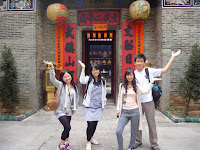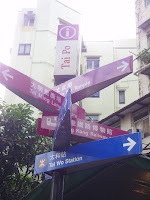Tai Po Man Mo Temple
History of Tai Po Man Mo Temple
 Man Mo Temple is a temple for the worship of the civil or literature god Man Tai (文帝) and the martial god Mo Tai (武帝). The two gods were popularly patronized by scholars and students seeking progress in their study or ranking in the civil examinations in the Ming and Qing dynasties.
Man Mo Temple is a temple for the worship of the civil or literature god Man Tai (文帝) and the martial god Mo Tai (武帝). The two gods were popularly patronized by scholars and students seeking progress in their study or ranking in the civil examinations in the Ming and Qing dynasties. Tai Po Man Mo Temple located in Fu Shin Street, was built in 1893 by a group of seven village communities of Tai Po – called Tsat Yeuk. This traditional Chinese architecture erected in commemoration of the new market - Tai Wo Shi - founding (now commonly known as Tai Po Market). The establishment of the market – and subsequent building of Kwong Fuk Bridge
 In the past, the temple was an administrative office of Tsat Yeuk and there was the court of arbitration to maintain the fair business. Simple accommodations were provided for worshipers and merchant s. In 1954, the temple completely became a place for religious purpose.
In the past, the temple was an administrative office of Tsat Yeuk and there was the court of arbitration to maintain the fair business. Simple accommodations were provided for worshipers and merchant s. In 1954, the temple completely became a place for religious purpose.  Nowadays, Tai Po Man Mo Temple maintains its typical
Nowadays, Tai Po Man Mo Temple maintains its typical What can you do there?
The front courtyard, planted with palms, provides shade for those taking a rest on the benches. Inside the temple, there is usually a crowd in the midst of lively conversation. It is a good way to approach and understand the local traditional culture. Of course, you may burn some joss sticks under large incense coils and make a wish to Man Mo
Tai Po Market
 From the Hang Dynasty in AD 963, the indigenous inhabitants of Tai Po lived by clamming and making pearls. The pearl making business reached its peak in the Song Dynasty and started to decline gradually in the midst of the Ming Dynasty. Tai Po had been developed as a fishing port around the late Ming Dynasty and the Qing Dynasty.
From the Hang Dynasty in AD 963, the indigenous inhabitants of Tai Po lived by clamming and making pearls. The pearl making business reached its peak in the Song Dynasty and started to decline gradually in the midst of the Ming Dynasty. Tai Po had been developed as a fishing port around the late Ming Dynasty and the Qing Dynasty.The 11th year of Kangxi Reign(1693), the dominant Tang’s clan applied for land to the Chinese Government to build the market. Because of the good location of the market where laid between the Kowloon , Shenzhen and fishing port, it became a transportation hub connecting China
The establishment of the market – and subsequent building of Kwong Fuk Bridge linking both sides of the Lam Tsuen River
at its centre. Fu Shin Street, 150 meters long, was the biggest market in the New Territories and now is one of the traditional markets in Hong Kong . Nowadays, Fu Shin Street is not as important as before although there are many shops selling the daily stuff and fresh products. It is worth visiting as there is still significantly reflecting the daily life of local people and Tai Po history.
This is an interesting experience to wander in the street. The hawkers bawl their fresh marine products and vegetable. The street is just outside the Man Mo Temple.


沒有留言:
張貼留言